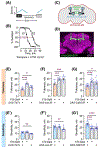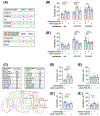Alcohol sensitivity and tolerance encoding in sleep regulatory circadian neurons in Drosophila
- PMID: 37500483
- PMCID: PMC10911855
- DOI: 10.1111/adb.13304
Alcohol sensitivity and tolerance encoding in sleep regulatory circadian neurons in Drosophila
Abstract
Alcohol tolerance is a simple form of behavioural and neural plasticity that occurs with the first drink. Neural plasticity in tolerance is likely a substrate for longer term adaptations that can lead to alcohol use disorder. Drosophila develop tolerance with characteristics similar to vertebrates, and it is a useful model for determining the molecular and circuit encoding mechanisms in detail. Rapid tolerance, measured after the first alcohol exposure is completely metabolized, is localized to specific brain regions that are not interconnected in an obvious way. We used a forward neuroanatomical screen to identify three new neural sites for rapid tolerance encoding. One of these was composed of two groups of neurons, the DN1a and DN1p glutamatergic neurons, that are part of the Drosophila circadian clock. We localized rapid tolerance to the two DN1a neurons that regulate arousal by light at night, temperature-dependent sleep timing, and night-time sleep. Two clock neurons that regulate evening activity, LNd6 and the 5th LNv, are postsynaptic to the DN1as, and they promote rapid tolerance via the metabotropic glutamate receptor. Thus, rapid tolerance to alcohol overlaps with sleep regulatory neural circuitry, suggesting a mechanistic link.
Keywords: Drosophila; alcohol tolerance; circadian rhythms; circuitry; sleep.
© 2023 Society for the Study of Addiction.
Conflict of interest statement
CONFLICT OF INTEREST STATEMENT
The authors declare no conflicts of interest.
Figures




Update of
-
Alcohol tolerance encoding in sleep regulatory circadian neurons in Drosophila.bioRxiv [Preprint]. 2023 Feb 2:2023.01.30.526363. doi: 10.1101/2023.01.30.526363. bioRxiv. 2023. Update in: Addict Biol. 2023 Aug;28(8):e13304. doi: 10.1111/adb.13304. PMID: 36778487 Free PMC article. Updated. Preprint.
References
Publication types
MeSH terms
Substances
Grants and funding
LinkOut - more resources
Full Text Sources
Molecular Biology Databases

